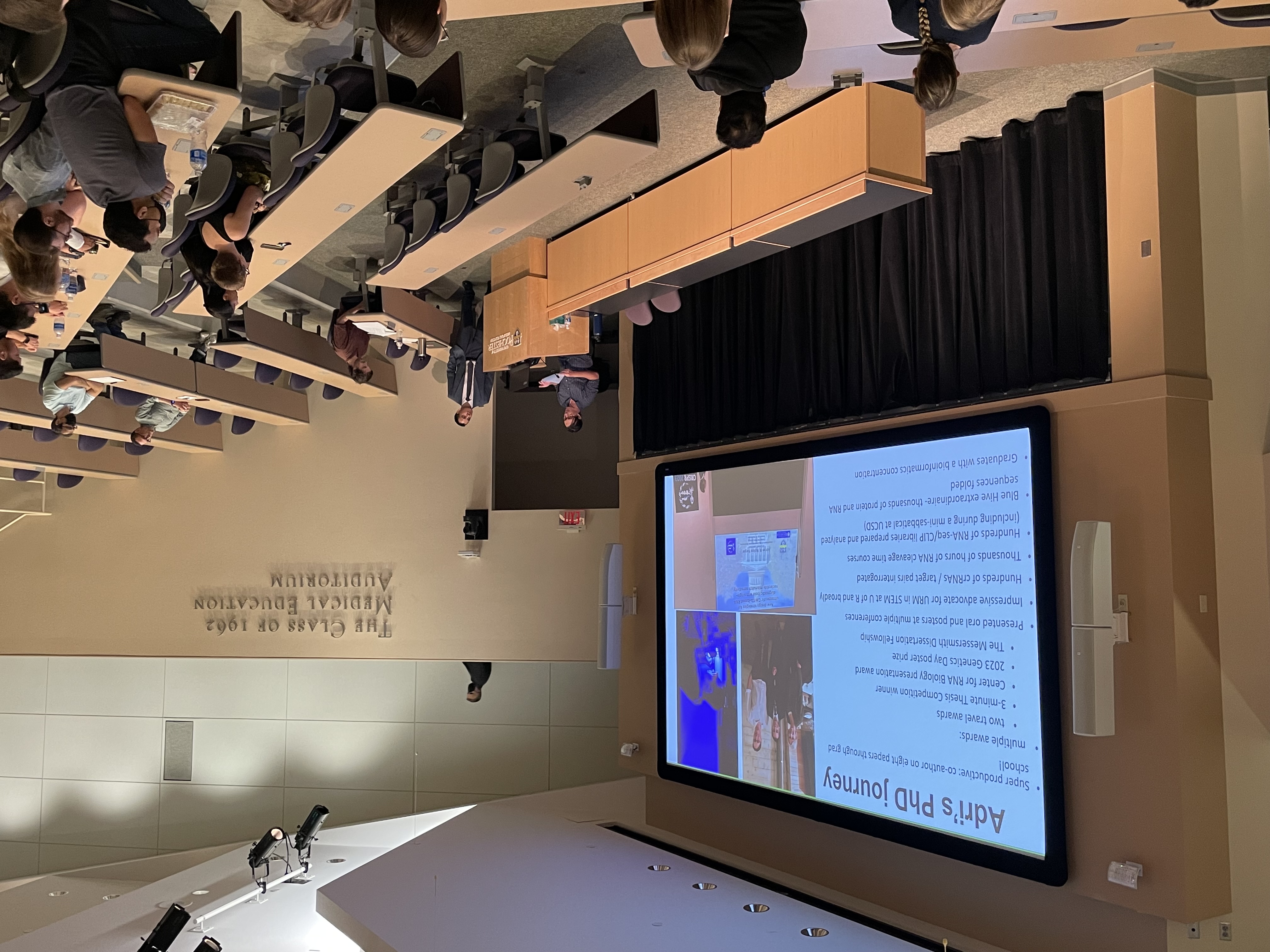News
20242023202220212020
Congratulations Dr. Molina Vargas!
Friday, September 8, 2023


On Thursday, September 7th, BGG Graduate Student Adrián Moisés Molina Vargas successfully defended his doctoral thesis: 'Developing Design Strategies for Efficient and Specific CRISPR Cas13 RNA-Targeting Applications'. From Spain, Adrián came to the University of Rochester in the fall of 2018. He pursued his thesis research, studying RNA biology and CRISPR-Cas systems, in the laboratory of his advisor Mitchell R. O'Connell, Ph.D., from the Department of Biochemistry and Biophysics (SMD). As a student, Adrián served in the leadership of the UR's Alliance for Diversity in Science & Engineering. Concluding his doctoral studies on a high note, in the summer of 2023, Adrian’s scientific research was distinguished when he earned a Messersmith fellowship.
Congratulations Dr. Molina Vargas!
Adrián’s thesis abstract can be read below.
ABSTRACT: Prokaryotic adaptive immune systems use Clustered Regularly Interspaced Short Palindromic Repeats (CRISPR) and CRISPR Associated (Cas) proteins to target and cleave foreign genetic elements in an RNA-guided manner. The recently described Type VI CRISPR-Cas system contains a single effector ribonuclease, Cas13, that binds and processes a guide-RNA (gRNA), forming an RNA-guided RNA-targeting protein complex. Cas13 has been successfully engineered for potent RNA-knockdown in eukaryotic cells with minimal off-target effects, and other exciting applications described to date include utilizing a nuclease-dead Cas13 (dCas13) as a programmable RNA-binding protein for RNA imaging, RNA- splicing, RNA-detection or RNA-editing applications, among others.
However, the principles of guide-RNA selection for efficient and specific Cas13-gRNA RNA binding remain elusive. Previous work indicates that gRNA choice is important because not all gRNAs yield a robust RNA-targeting, and it is likely that there are different gRNA requirements for RNA-binding compared to RNA-cleavage applications. Furthermore, no predictive models exist for guide-RNA binding efficiency and specificity for Cas13 because no systematic binding screens have been carried out. Given that no transcriptome-wide measurements of Cas13-binding specificity have been attempted so far, it is unknown what the Cas13 off-target binding landscape is for human cells. Addressing this knowledge gap and quantitatively understanding the differences between binding and cleavage specificities is integral to the development of specific Cas13 RNA-binding applications. In this project, we have developed an RNA interactome assay based on eCLIP (enhanced Crosslinking and Immunoprecipitation) that allows to capture Cas13 RNA binding and the crRNA that elicited it, which in turn will help us understand binding specificity of Cas13 in a high-throughput manner.
Moreover, similar gRNA design challenges occur in the CRISPR diagnostics space, as exploration of the principles for gRNA design in the context of Cas13-based diagnostics has been limited, leaving it a case-by-case basis exploration of suitable crRNAs. This is particularly relevant when deploying Cas13 to distinguish a pathogen’s genetic variation or whether a sample is pathological or not. Further progress in the diagnostic field requires a deeper understanding of the biophysical parameters that underlie Cas13 RNA-recognition and activation, which in turn will guide the rational design of more specific Cas13 RNA-diagnostics. By using various methods including mismatch tolerance profiling, gRNA length studies, and structure-guided engineering of Cas13a, we report new strategies and Cas13a variants that yield highly specific discrimination of RNA-targets down to single-nucleotide polymorphisms (SNP). We deployed this novel platform for the detection of single-nucleotide polymorphisms in SARS-CoV-2 variants of concern and showed its potential for disease diagnostics or epidemiological surveillance.
In sum, this work will help complete our understanding of the gRNA requirements for on-target efficiency; but more importantly, it will assist us in uncovering what gRNA features contribute to off-target effects that could hinder the use of Cas13 as a specific RNA-targeting tool. Taken together, my project will bolster efforts to develop a range of RNA-targeting applications that can be readily used as research tools to address knowledge gaps in RNA biology and as potential therapeutics.
BGG student Daxiang Na Successfully Defends Thesis!
Monday, July 24, 2023

 On Thursday July 20th 2023, BGG student Daxiang Na defended his thesis. After joining the BGG program in 2018, Daxiang pursued his thesis research in the laboratory of Dr. Patricia White.
On Thursday July 20th 2023, BGG student Daxiang Na defended his thesis. After joining the BGG program in 2018, Daxiang pursued his thesis research in the laboratory of Dr. Patricia White.
Daxiang's thesis is titled 'An Investigation of the Relationship between Auditory Dysfunctions and Alzheimer’s Disease Using Amyloidosis Mouse Models.' Daxiang's abstract can be read below.
Congratulations Daxiang!
Abstract: Alzheimer’s Disease (AD) is a neurodegenerative illness without a cure. All current therapies require an accurate diagnosis and staging of AD to ensure appropriate care. Central auditory processing disorders (CAPDs) and hearing loss have been associated with AD, and may precede the onset of Alzheimer’s dementia. Therefore, auditory dysfunction is a possible biomarker candidate for AD diagnosis. However, little is known about how auditory dysfunction and AD pathological changes are correlated. In the present study, we investigated the auditory dysfunctions in AD with transgenic amyloidosis mouse models 5xFAD and APP/PS1. AD mouse models were bred on a CBA and C57BL/6 hybrid background, to compensate for the accelerated hearing loss on the C57BL/6 background. Auditory brainstem response (ABR) recordings revealed significant hearing loss, a reduced ABR wave I amplitude, and increased central gain in 5xFAD mice. In comparison, these effects were milder or reversed in APP/PS1 mice. Longitudinal analyses revealed that in 5xFAD mice, central gain increase preceded ABR wave I amplitude reduction and hearing loss, suggesting that it may originate from lesions in the central nervous system rather than the peripheral loss. Histology analysis showed amyloid plaque deposited in the auditory cortical regions and upper auditory brainstem of 5xFAD mice, including the inferior colliculus (IC) and the medial geniculate body (MGB), but not lower levels of auditory brainstem. This plaque distribution parallels histological findings from human subjects with AD, and consistent with publicly available datasets of plaque distribution in similar mouse models. Interestingly, anatomical analysis did not show significant change in the cochleae of those 5xFAD mice, which have already shown hearing loss. Pharmacologically facilitating cholinergic signaling with donepezil reversed the central hyperactivity in 5xFAD mice. After the central gain increased, aging 5xFAD mice developed deficits for hearing sound pips in the presence of noise, consistent with CAPD-like symptoms of AD patients. Overall, we conclude that auditory alterations in amyloidosis mouse models may correlate temporally with amyloid deposits in the auditory brainstem and may be reversed initially through enhanced cholinergic signaling. The alteration of ABR recording related to the increase in central gain prior to AD- related hearing disfunction suggests it could potentially be used as an early biomarker of AD diagnosis.
BGG Student Tom O’Conner Successfully Defends Thesis!
Friday, July 14, 2023

 On Wednesday July 12th BGG student Tom O’Connor successfully defended his thesis. Tom earned his B.S. in Biotechnology from the University of Buffalo in 2017. As a Ph.D. student Tom pursued his doctoral research in Dr. Robert T. Dirksen’s laboratory. Tom is currently a Scientist at Roswell Park Comprehensive Cancer Center.
On Wednesday July 12th BGG student Tom O’Connor successfully defended his thesis. Tom earned his B.S. in Biotechnology from the University of Buffalo in 2017. As a Ph.D. student Tom pursued his doctoral research in Dr. Robert T. Dirksen’s laboratory. Tom is currently a Scientist at Roswell Park Comprehensive Cancer Center.
Tom’s Thesis is titled ‘Adaptive and Protective Responses of Skeletal Muscle to Endurance Exercise in the Context of Aging, Juvenile Radiotherapy, and Tubular Aggregate Myopathy’.You can read his thesis abstract below.
Congratulations Tom!
Abstract: Endurance exercise elicits a multitude of adaptive and protective responses to skeletal muscle in response to prolonged training. These include renewal and contribution of muscle stem cells (or satellite cells, SCs) to growing and repairing myofibers, improved proteostasis, adapted calcium handling and mitochondrial dynamics, and scavenging of elevated reactive oxygen species. In this work, endurance exercise was implemented as a therapeutic intervention in mouse models of aging, juvenile irradiation, and congenital myopathy to assess whether the adaptive responses of skeletal muscle to endurance exercise would confer protective and/or restorative effects in the context of disease. Frailty is an extremely common condition in both elderly individuals and juvenile cancer survivors, characterized by reductions in muscle mass (sarcopenia) and strength (dynapenia). Individuals born with rhabdomyosarcoma, a common form of childhood cancer that primarily affects skeletal muscle, are often treated by surgical resection of the tumor and subsequent ionizing radiation therapy. Due to recent medical advancements, pediatric cancer survivorship is improving. However, these individuals often suffer into adulthood from the cytotoxic effects of radiation therapy received during development. Using aged mice and a clinically relevant juvenile irradiation protocol, we assessed the impact that one month of voluntary wheel running (VWR) exercise had on aged and irradiated skeletal muscle. Regarding SCs, we found that exercise activated the muscle stem cell pool in aged mice in a similar manner to what was observed in adult mice. Although aged SCs were able to activate, they were unable to terminally commit and fuse to the myofiber to maintain and repair skeletal muscle tissue, as observed in the adult cohort. This observation was consistent with an elevated autoregulatory inflammatory signature observed in aged SCs post-endurance exercise ince SC activation and commitment was observed in the adult cohort, we hypothesized that post-juvenile irradiation endurance exercise would elicit SC contribution to the myofiber and minimize the deficits seen in irradiated muscle. While we did not observe significant contribution of SCs to irradiated muscle post-endurance exercise, we found that adapted calcium handling, scavenging of reactive oxygen and nitrogen species, and adapted mitochondrial dynamics was consistent with improved irradiated muscle function and contractile kinetics. Based on these observed adaptations of skeletal muscle to endurance exercise in the context of irradiation, we implemented a prolonged endurance exercise regimen as a preventative intervention in a novel mouse model of tubular aggregate myopathy (TAM). TAM is a congenital myopathy typically caused by gain of function mutations in the store- operated calcium machinery STIM1 and ORAI1 and can be characterized by the formation of tubular aggregates (TAs) in skeletal muscle. TAM patients commonly present with progressive muscle weakness, cramps, and myalgia. In our TAM mouse model, we observed robust formation of TAs and disrupted skeletal muscle function. However, prolonged endurance exercise reduced the presence of TAs and improved muscle function consistent with adapted calcium handling, proteostasis, metabolism and mitochondrial dynamics.
Iron & the brain: Where and when neurodevelopmental disabilities may begin during pregnancy
Monday, March 6, 2023
Study finds possible cellular origin for impairments associated with gestational iron deficiency
The cells that make up the human brain begin developing long before the physical shape of the brain has formed. This early organizing of a network of cells plays a major role in brain health throughout the course of a lifetime. Numerous studies have found that mothers with low iron levels during pregnancy have a higher risk of giving birth to a child that develops cognitive impairments like autism, attention deficit syndrome, and learning disabilities. However, iron deficiency is still prevalent in pregnant mothers and young children.
The mechanisms by which gestational iron deficiency (GID) contributes to cognitive impairment are not fully understood. The laboratory of Margot Mayer- Proschel, PhD, a professor of Biomedical Genetics and Neuroscience at the University of Rochester Medical Center, was the first to demonstrated that the brains of animals born to iron-deficient mice react abnormally to excitatory brain stimuli, and that iron supplements giving at birth does not restore functional impairment that appears later in life. Most recently, her lab has made a significant progress in the quest to find the cellular origin of the impairment and have identified a new embryonic neuronal progenitor cell target for GID. This study was recently published in the journal Development.
“We are very excited by this finding,” Mayer-Proschel said, who was awarded a $2 million grant from the National Institute of Child Health & Human Development in 2018 to do this work. “This could connect gestational iron deficiency to these very complex disorders. Understanding that connection could lead to changes to healthcare recommendations and potential targets for future therapies.”
Read More: Iron & the brain: Where and when neurodevelopmental disabilities may begin during pregnancy